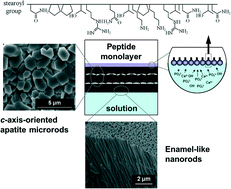Fabrication of self-standing films consisting of enamel-like oriented nanorods using artificial peptide
Abstract
We achieved the fabrication of enamel-like films consisting of c-axis-oriented hydroxyapatite (HA) nanorods by a two-step controlled crystal growth method with the monolayer of a specific artificial peptide binding to the c face of HA. Self-standing films were formed under the monolayer at the air–water interface in an aqueous solution system that was based on a simulated body fluid. The presence of fluoride ions promoted the arrangement of apatite microrods in the c direction through geometric selection. The subsequent growth with aspartic acid produced the enamel-like structure consisting of c-axis-oriented nanorods on the basal microrods. Therefore, the controlled crystal growth using the aqueous system including the specific artificial peptide, fluoride ion, and aspartic acid is regarded as a novel fabrication route for well-organized architectures.


 Please wait while we load your content...
Please wait while we load your content...